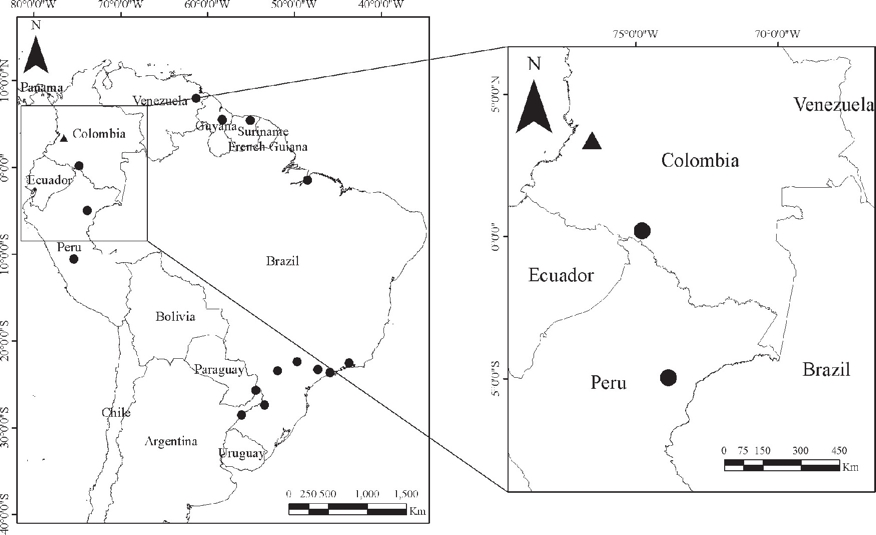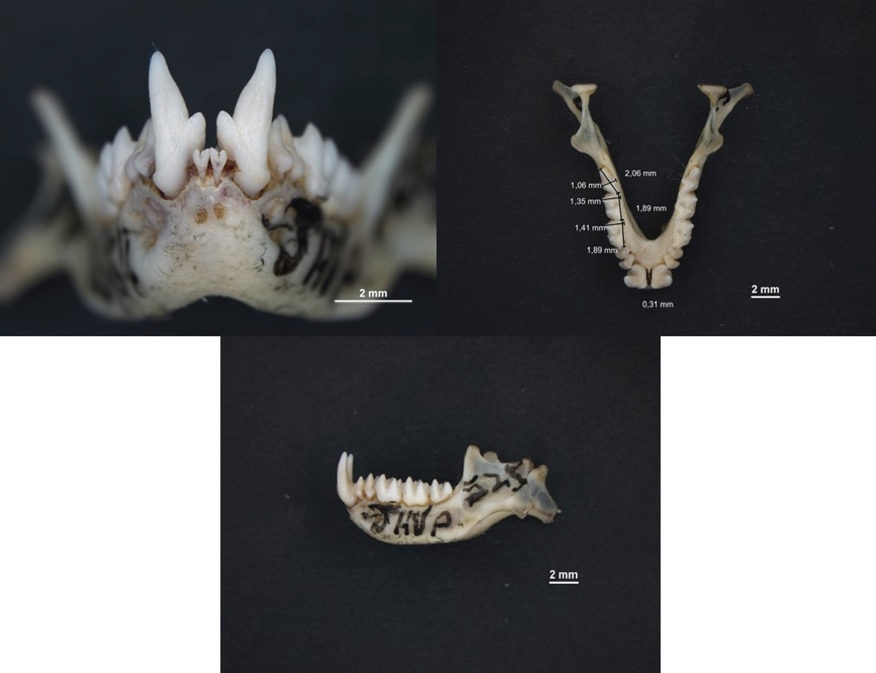Bat species of the genus Molossops Peters, 1866 (Chiroptera, Molossidae) are restricted to South America and are distinguished from other molossids by a relatively large tragus (at least half the size of antitragus), a short and wide antitragus, elongated and pointed ears that have a flexible fold where they are attached to the head, and a single pair of incisors in the mandible (Gregorin & Taddei 2002; Eger 2008). Molossops includes two species: the dwarf dog-faced bat M. temminckii Burmeister, 1854, which is relatively common and occurs in Colombia, Venezuela, and Guyana in the north to Ecuador, Peru, Bolivia, Paraguay, Argentina, Uruguay, and Brazil in the south (Simmons 2005; Eger 2008); and the rufous dog-faced bat M. neglectus Williams and Genoways, 1980, which is considered rare and occurs disjunctively in northern South America (Guyana, Suriname and Venezuela), in the Amazon basin (southern Colombia and northern Peru), and in southern Brazil and northern Argentina (Lim & Engstrom 2001; Gregorin et al. 2004; Barquez et al. 2011).
Molossops neglectus is distinguished from its congener by its dark brown dorsal fur, slightly darker belly and being proportionately larger in its external size (forearm larger than 36 mm in M. neglectus and less than 33 mm in M. temminckii) as well as cranial measurements (total length of skull larger than 16 mm in M. neglectus and less than 15 mm in M. temminckii; Gregorin & Taddei 2002; Gregorin et al. 2004; Eger 2008). Occurrence records indicate that M. neglectus lives mainly within the Amazon rainforest in northern South America, and the semi-deciduous forest of northern Argentina and southern Brazil (Gregorin et al. 2004). In Colombia it is known by a specimen collected in 1968 in Puerto Leguízamo, Putumayo Department (Amazon basin), near the border with Peru (Lim & Engstrom 2001).
On August 10th 2012 an adult male M. neglectus (positive epididymis, testicle 6.5 mm) was captured at the “Estación Experimental de Biología”, on the campus of the Universidad del Valle, Cali municipality, Valle del Cauca department, Colombia (3°22’34’’ N, 76°31’58’ W’, 1000 m; Figure 1). The capture was made at approximately 18:30 hours, using mist nets (12 x 3 m) located 1 m above the ground in an open area during a survey whose objective was the capture of birds for studies of reproductive biology. The specimen was collected and preserved as a skin, skull and partial skeleton, and housed in the collection of mammals at the Department of Biology, Universidad of Valle (UV-13984; Figure 2). Other molossid species occurring sympatrically with M. neglectus in this locality are Molossus molossus Pallas, 1766, M. pretiosus Miller, 1902, Tadarida brasiliensis I. Geoffroy St. Hilaire, 1824, Eumops auripendulus Shaw, 1800 and E. glaucinus Wagner, 1843.

Figure 1 Map showing the known localities of Molossops neglectus in South America (left), indicating in detail the new record (right). Historical records are represented by circles (Gregorin et al. 2004) while the triangle indicates the new record.

Figure 2 An adult male of Molossops neglectus collected on the campus of the Universidad del Valle, Cali municipality, Valle del Cauca department, Colombia (Photo by Jorge H. Velandia-Perilla).
The external and cranial measurements (in mm) and weight (g) of the specimen were taken following Freeman (1981) and are compared with the range reported by Lim & Engstrom (2001) for the species (Table 1). Detailed pictures of skull were taken in the Laboratory of Images of the Biology Department, Universidad del Valle (Figures 3 and 4). M. neglectus exhibits sexual dimorphism, with males considerably larger than females (Ascorra et al. 1991); our specimen (UV-13984, an adult male) is no exception to this, and most of its measurements are slightly larger than those recorded for the species.
Table 1 External and cranial measurements (in mm) and mass (in grams) of a male of Molossops neglectus (UV - 13984) and range reported for the species (Lim & Engstrom 2001).


Figure 3 Frontal, lateral, dorsal and ventral view of the skull of Molossops neglectus (UV-13984) collected on the campus of the Universidad del Valle, Cali municipality, Valle del Cauca department, Colombia (Photos by Daniela Arenas-Viveros).

Figure 4 Frontal, dorsal and lateral view of the mandibles of Molossops neglectus (UV-13984) collected on the campus of the Universidad del Valle, Cali municipality, Valle del Cauca department, Colombia (Photos by Daniela Arenas-Viveros).
This record is noteworthy because it is geographically isolated from the species’ known distribution range and represents the only observation in the west of the Andes. Similarly, disjunct distribution patterns have been reported for other molossids such as Cynomops abrasus and Molossops temminckii (Alberico & Naranjo 1982; Eger 2008), indicating the Andes mountain range is not a geographic barrier for some species of the group. Despite the slightly larger size of the specimen captured compared with other M. neglectus, we are reluctant to assign it to an undescribed taxon; there are few morphometric data on the species and its true size range is unknown. We here assign it tentatively to M. neglectus and anticipate that further surveys will provide the additional morphological and molecular data needed to perform a more in-depth analysis of the identity of this group.
The species has been recorded in primary and secondary forests (Gregorin et al. 2004). Its presence on the campus of the Universidad del Valle, a wooded area of approximately 100 ha located in an urban matrix in southern Cali, supports previous observations that the species is tolerant of disturbance (Gazarini & Bernardi 2007). This is the second report of the species for Colombia, and represents an extension of its known range by at least 450 km to the northwest (Figure 1).
The rufous dog-faced bat was previously known from humid regions such as the Amazon forests and the Atlantic coast forests in Brazil. In contrast, the vegetation at our site consists of the dry forest typical of the Cauca Valley with extended periods of drought. Therefore, this record demonstrates that the species’ distribution covers various ecosystems; it also represents an extension of habitat for M. neglectus, and a large increase in the area and potential ecosystem used by it. It is likely that the species is distributed along the Rio Cauca basin and even further north. This record emphasizes the need for an increase in the species’ representation in collections in order to understand better its distribution.
Bats have been caught on the campus of the Universidad del Valle from the 1980s as part of the courses “Mammalogy” and “Natural History of Vertebrates”, and with this record the presence of 12 species is confirmed. The absence of previous records of the species in this area is probably due to the difficulty of capturing insectivorous bats with ground-level mist nets, since molossids fly higher. It is essential that the use of mist nets is complemented by other methods (e.g. harp traps, active search of roosts, echolocation call recordings) in further studies to detect species difficult to capture with nets. This record highlights the necessity of further research on a poorly known bat species.











 nueva página del texto (beta)
nueva página del texto (beta)


